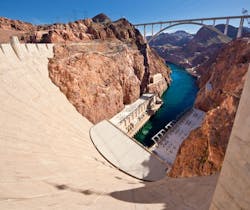The engineering behind the Hoover Dam and its bypass
The Hoover Dam, and the newly constructed Hoover Bypass, or Mike O'Callaghan – Pat Tillman Memorial Bridge, are engineering marvels that embody American ingenuity, grit and power. However, these public works share more than the Colorado River. They stand out as monuments of determination and exemplify how technology and chemistry contribute to engineering success.
Hoover Dam Transforms Colorado River Into Economic Growth Resource
Before the Hoover Dam transformed the raging, flood-prone Colorado River into a resource for economic growth, it took a team of 200 engineers to achieve what many thought was impossible: design a dam that could hold back a 500-ft-deep, 10-trillion-gal reservoir; enough water to cover the state of Connecticut 10 ft deep.
The resulting concrete arch-gravity design, allowing the water load to be dispersed by both the gravity and horizontal arch action, was the winning solution. It would take a lot of concrete to make this work. In fact, even with this design, the dam would need to resist the water pressure more than 45,000 lb per square foot at the base of the dam.
By its completion in 1935, the Hoover Dam was the greatest concrete project ever recorded, using more masonry than the Great Pyramid at Giza (4.5 million cu yd) and equal to the amount needed to build a two-lane highway from Seattle to Miami, or a 4-ft-wide sidewalk around the Equator.
To this day, it remains the highest dam in the Western Hemisphere. Towering 726 ft above the Colorado River, it is 1,244 ft across at the top, 660 ft thick at the base and 45 ft thick at the top and weighs in at whopping 6.6 millions tons.
To make the concrete durable, strong and increasing its overall performance, the engineers specified a new innovation in concrete admixtures: Pozzolith water-reducing admixtures, invented in 1932 by Master Builders, now a BASF brand. Later, Watson Bowman Acme, a BASF company, provided Jeene expansion joint systems and slider plate assemblies, adding corrosion and structural protection, while accommodating thermal and seismic movements, vehicle impact and structural loads.
75 years later, construction began on the Mike O'Callaghan – Pat Tillman Memorial Bridge. The bridge would provide an improved, safer (less windy), shorter route between Las Vegas and Phoenix and provide additional security for the Hoover Dam against attacks.
Today the four-lane bridge is the first concrete-steel composite arch bridge built in the U.S. At 840 ft above the Colorado River, it is the second-highest bridge in the country and the longest arched concrete bridge in the Western Hemisphere.
The Hoover Dam Bypass is designed and constructed to last for more than 100 years.
To accomplish this, the bridge was engineered to accommodate the normal expansion and contraction of concrete due to factors including temperature and weather changes, vehicular weight and movement. Watson Bowman Acme bridge expansion joints are integral part to this solution.
Seismic activity was another key consideration for this project. The expansion joints selected for this project were engineered to withstand seismic movement. The Wabo Modular expansion joints by Watson Bowman Acme provide the flexibility needed to absorb these shocks.
Additionally, the Watson Bowman Acme team worked closely with the construction team to fabricate custom steel handrails for the pedestrian walkways.
For more information about BASF’s contribution to durable, long-lasting bridges, please visit construction.basf.us.
